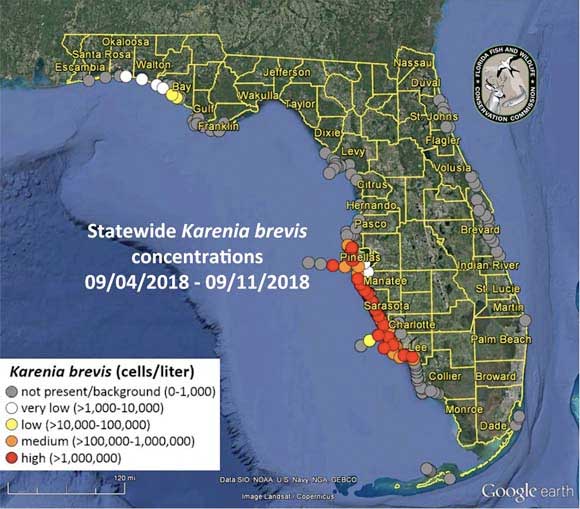A bloom of the Florida red tide organism, Karenia brevis, persists in Southwest Florida and extends from northern Pinellas to Lee counties along ~125 miles of coastline. Aerial surveys conducted on 9/6 and 9/11 as well as recent water sampling indicate that the bloom of K. brevis still extends offshore (10 miles or more) in some areas. A bloom of K. brevis was also observed in Northwest Florida for the first time this past week.
Observations of >1,000,000 K. brevis cells per liter (“high” concentrations) occurred in samples collected in or offshore of Pinellas, Manatee, Sarasota, Charlotte, and Lee counties and relative to last week, multiple locations in Pinellas, Sarasota, Charlotte and Lee counties showed increased K. brevis concentrations. Decreased cell concentrations were observed in Collier County. In Northwest Florida, very low to low cell concentrations (<100,000 cells per liter) were reported from Okaloosa to Bay counties.
In Southwest Florida, reports of fish kills were received for multiple locations in and/or offshore of Pinellas, Manatee, Sarasota, and Lee counties. In Northwest Florida, reports of fish kills were received in and offshore of Panama City Beach (Bay County). Respiratory irritation was reported in Southwest Florida (in Pinellas, Manatee, Sarasota, and Lee counties).
Forecasts by the USF-FWC Collaboration for Prediction of Red Tides for Pinellas to northern Monroe counties predict net southern movement of surface waters for most areas and net southeastern transport of subsurface waters over the next three days. Forecasts for Northwest Florida predict net eastern transport of surface and subsurface waters.
This information, including maps and reports with additional details, is also available on the FWRI Red Tide website. The website also provides links to additional information related to the topic of Florida red tide including satellite imagery, experimental red tide forecasts, shellfish harvesting areas, the FWC Fish Kill Hotline, the Florida Poison Information Center (to report human health effects related to exposure to red tide), and other wildlife related hotlines.
To learn more about various organisms that have been known to cause algal blooms in Florida waters, see the FWRI Red Tide Flickr page. Archived status maps can also be found on Flickr.
The FWRI HAB group in conjunction with Mote Marine Laboratory now have a Facebook page. Please like our page and learn interesting facts concerning red tide and other harmful algal blooms in Florida.

